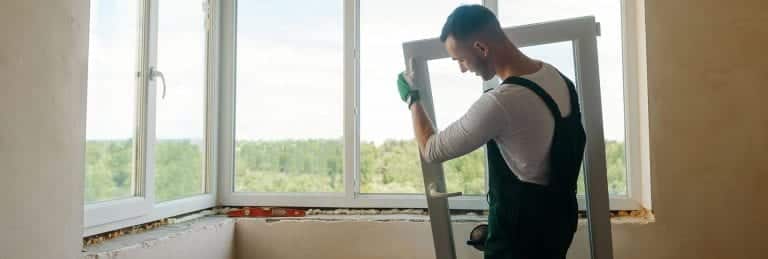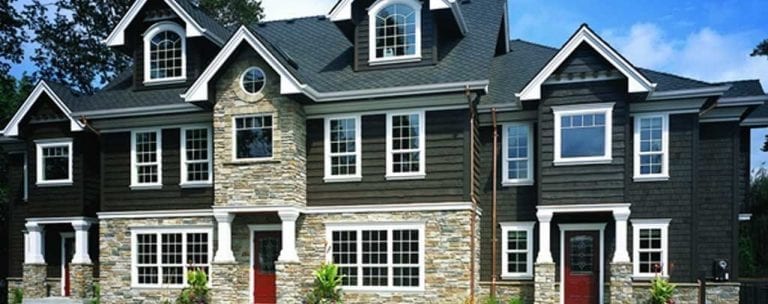Choosing the Right Storm Doors and Storm Window for Your Home

If you’re in the market for a storm door or storm window, you probably have plenty of questions. You might’ve been told that installing one can save you money and make life easier during difficult weather, yet you don’t exactly understand how. That’s why we’ve built this guide—to teach you everything you need to know about storm doors and storm windows.
Let’s get started.
What is a Storm Door?
In an oversimplification, a storm door is a second door outside of an exterior door. To take its name into consideration, it’s a door before the storm. Storm doors provide an extra layer of protection against bad weather and can increase ventilation when the climate is graceful and balanced.
Storm doors generally feature a layer of insulation and glass that allows sunlight to pass through the doorway when the main door is open. This glass protects from wind and rain when the weather is poor, but still allows you to open the main door and enjoy the view. In better weather, the glass panel of the storm door can be replaced by a screen, inviting the breeze into the house while keeping insects out.
Benefits of a Storm Door
There are many benefits to installing a storm door in your entrance door design, and they’re often driven by the type of climate a home experiences. These benefits include but are not limited to:
- Ventilation in good weather
- Facilitating natural sunlight
- Protecting against insects
- Exterior visibility with outdoor protection
- Protection from rain, ice, snow, and wind
What’s the Difference Between a Storm Door and a Screen Door?
A storm door is much sturdier than a screen door. Additionally, a storm door is insulated, while a screen door is nothing but mesh held in place by an aluminum frame. A screen door is great for letting in the breeze and keeping out the bugs, but unlike a storm door, it offers no protection against cold and rain.
What About Storm Windows?
As with storm doors, storm windows are windows on windows. They provide extra wind protection and weather insulation. When it comes to their installation, the process can differ. For instance, a storm window can be installed on either the inside or outside of an existing window. Depending on the climate, they can also offer the optionality of being replaced by a screen during warmer months.
Do I Need a Storm Door or Storm Windows?
Whether or not you need storm doors or windows depends on your house, the geography you’re in, and even your lifestyle. If your front door needs protection from wind and rain, a storm door might do the trick.
However, in warmer states, storm doors aren’t usually necessary. Instead, screen doors are the most viable options seeing as they guard against pests but facilitate a breeze. If you live in an area with a harsher climate, you might also be able to opt-out of storm doors or storm windows under a few conditions:
- If you have newer, well-sealed, and energy-efficient doors and windows, storm doors and windows may be redundant
- You might not need a storm door if your door is already protected from the elements by a porch or overhang
- If your door receives more than a few hours of direct sunlight during the day, a storm door might damage your main door by trapping too much heat against it
Should I Use Just Replace My Existing Doors and Windows?
Once again, it depends. Storm doors and storm windows are typically less expensive than replacing main doors and windows with energy-efficient materials. But if you can afford the upgrade, it could be an economic decision that pays dividends over time (rather than buying new storm windows every two to three years).
If your current windows are more than 30 years old, it’s probably a good idea to replace an old window with energy-efficient replacement window designs.
How Do I Choose a Storm Door or Storm Window?
If you need new storm doors or storm windows, it’s time to decide which ones to buy. Let’s start with the storm door.
What to Look for in a New Storm Door
Storm doors come in a variety of materials and can range in price from $100 to more than $1,000. With that being said, here are a few things to keep in mind when deciding on your storm door:
- Vinyl-clad – This material is inexpensive, but stands up well to snow and ice
- Steel-clad – This material is rugged and long-lasting, and comes in many color options
- Aluminum – This material is as durable as steel but lighter in weight
The windows in storm doors come in several styles:
- Full-view – Storm doors with full-view windows feature glass from top to bottom within a narrow frame. Sometimes this glass is fixed in place; other times, the top half is a pane that can slide down, leaving an open window that can hold a screen.
- Half-view – The top half is a window while the bottom half is solid. The window can open by sliding down into the lower compartment.
- High-view – For more privacy, a smaller panel is located high up in the door. Sometimes this window can open; in other designs, it’s fixed in place.
With that being said, here are a few other characteristics you should consider when deciding on the right type of storm door for your property:
- Tempered glass for safety
- Energy-efficient double- or triple-paned glass
- Etched, frosted, or stained glass panels
- Mini-blinds incorporated into the windows
- Built-in pet doors
Storm Door Installation
First things first: you’ll need to take careful measurements to ensure you’re buying the right size door for your opening. To that end, most exterior doors are 80 inches high and 36 inches wide, but these numbers can vary.
Keep in mind that storm doors are often reversible—meaning you can install them with hinges on the left or the right, depending on your preference—but double-check before you make a purchase to ensure it will fit the way you want it to. The storm door will come with a top jamb, hinge jamb, and strike jamb that you will need to attach to your main door jamb. Then you’ll hang the door to this new jamb. The only other step is attaching a handle to the new storm door. Handles are often sold separately, so you can purchase one that matches the style of your home’s architecture.
What to Look for in Your New Storm Window
When it comes to storm windows, you have several options. These include but are not limited to:
- Interior Storm Windows – Inexpensive plastic, glass, or acrylic storm windows can be customized to fit interior window frames with a tight insulating (and sound-reducing) seal.
- Pros: looks just like a window, UV filtering, acoustic dampening
- Cons: can be difficult to install and maintain
- Temporary/Disposable Storm Windows – As with interior storm windows, these single acrylic panels fit inside the interior window frame. They attach with adhesive tape and are bonded (by using heat) for a tight seal.
- Pros: inexpensive; performs as well as an internal window if installed correctly
- Cons: not designed to last more than a season or two, easily damaged
- Exterior Storm Windows – Typically available in wood, vinyl, and aluminum storm windows frames, these attach outside the main windows.
- Pros: durable and effective
- Cons: difficult storm window installation, requires regular maintenance, aluminum storm frame is a typically poor insulator, wood storm window frames weather over time
With these options highlighted, it’s important to mention that modern exterior storm windows come in a variety of configurations that are easier to use (once installed) than older-style exterior storm windows. These include but are not limited to:
- A two-track storm window has an inside pane that can be raised to allow fresh air to enter through a half-screen at the bottom of the window.
- A triple-track window has two panes and a half-screen that can each be moved independently to vary the location of the opening.
- Picture-style or basement storm windows feature a single pane of glass secured by thumb latches.
Storm Door and Storm Windows from The Glass Guru
With vast optionality and many nuances, finding the right storm door or storm windows takes time, research, and a little patience. If you’re looking for the right product and the experts to install it, then welcome to The Glass Guru. Whether you need some guidance in your buying journey, a professional to handle the installation, or you just need a few questions answered, we’re your go-to glass experts.
Ready to find the right storm door or storm window for your home? Reach out to us today and let’s get started.
Sources:
Angie’s List. Are Storm Doors Really Necessary? https://www.angieslist.com/articles/are-storm-doors-really-necessary.htm
Houzz. Glass storm/screen door gets blazing hot in summer. https://www.houzz.com/discussions/2638585/glass-storm-screen-door-gets-blazing-hot-in-summer











